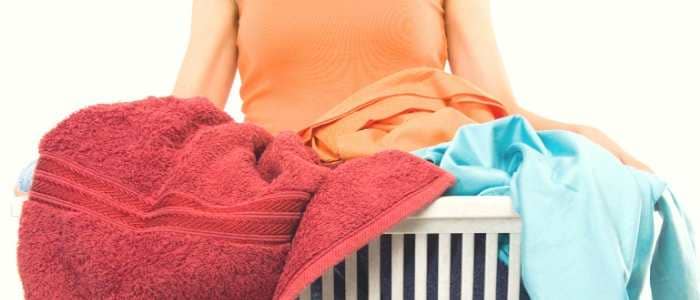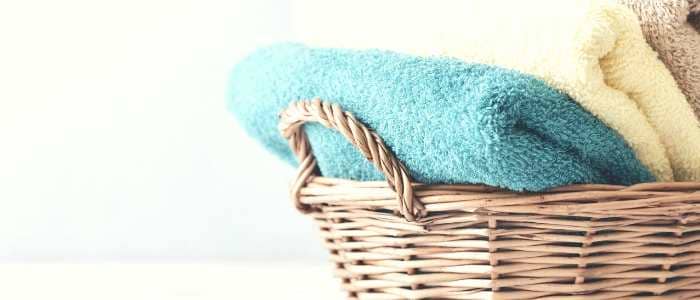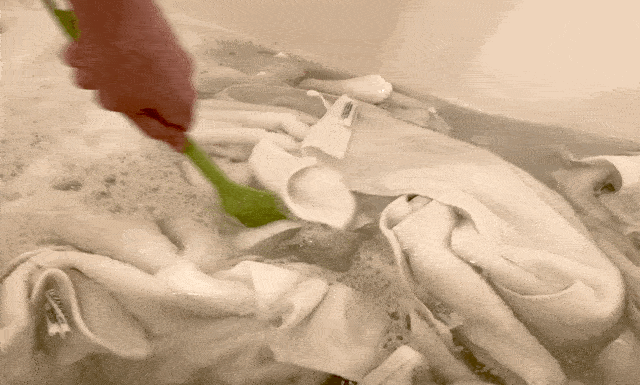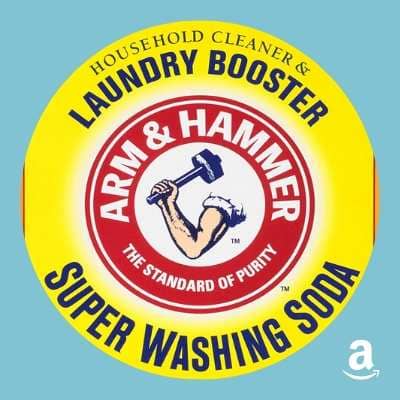I recently started noticing problems with my laundry not getting as clean as I would prefer. My towels had a mildew smell, my bedsheets wouldn’t smell fresh even after washing, my kids’ play clothes had funky smells, and our dogs’ bedding reeked after washing too. I was to the point of desperation. I needed to figure out how to get all of my laundry to smell good again.

Years ago, when my kids were babies, we dabbled a bit with cloth diapering and I remembered the recommendations on the various cloth diapering forums to do a stripping if you had stink problems. I never had issues with my cloth diapers, so I have never done a stripping, but it got me to thinking about the rest of my laundry and if stripping could work for other stuff too.
So I took a cruise around Pinterest to see if anyone was stripping other things besides diapers, and sure enough, I found plenty of people telling how to strip clothes, bedsheets, stinky towels, workout clothes, and underwear – there’s some really gross stuff about laundering underwear by the way…
I decided to give this stripping your laundry thing a try with my smelly towels and bedsheets and share the results with you here.
What is Strip Washing?
Stripping your laundry is a way to break down the build-up caused by mineral deposits, laundry detergent, fabric softener, body oils, bacteria, and other gross things you don’t want lurking about. This deep cleaning method is useful if your laundry isn’t smelling fresh, or you are having problems with dingy or dirty looking laundry.
When You Need a Strip Wash
Build-up of Soap and Oil Residue
There are a variety of things that can cause build-up and residue in your clothes and linens.
Hard water – minerals in hard water build-up in fabrics over time.
Detergent residue – detergent not being thoroughly rinsed from the fabric during washing.
Fabric softener – liquid fabric softener coats fibers to soften them, often leading to loss of absorption and odor in fabric.
Personal products – deodorant, perfume/cologne, lotions, body butter, oils, creams, hair products, etc. collect in our clothing and towels.
Human grossness – sweat, oils, bacteria, and other body secretions…eww
Second-Hand or Thrifted Items
If you got clothes or linens that were previously owned from a thrift store or other secondhand shop, then it would be a good idea to do a strip and sanitize wash since you can’t be sure of the washing care that item received in its past life. However, a strip wash may not be necessary if you received the item used from someone you know.
Heavily Soiled Clothing
Laborers and folks that work outdoors may have clothes with built-up dirt or grease (depending on the profession) that may require stripping for a deep clean. If your clothing is looking dirty and grimy even after washing, then your regular washing routine may not be enough to tackle it, and an occasional strip washing may be necessary.
Laundry Doesn’t Smell Fresh
No matter what you do or how many times you wash, your laundry still doesn’t smell clean and fresh as it should. Towels are coming out of the dryer still stinky and smelly. Kitchen rags reek when they get wet. Then it might be time for a stripping and deep clean.
It’s important to note that while strip washing is great for that oh so gratifying deep clean to get what some say is a “blank slate” or “fresh start” that you do not strip your laundry too often. The process can be harsh on fabrics, so be careful not to overdo it.
Stripping Towels
I decided to take on my smelly towels first. Bath towels can get especially icky from soap residue from washing as well as from the oils on our bodies. If you have super hard water as I do, then you have even more potential for that disgusting mildew smell in your towels.

I have already tried vinegar, baking soda, and borax, among other things, to get rid of the mildew smell in my towels. That said, I was not expecting to have overly impressive results with this strip wash, but I gave it a go anyway. My hope was that, at minimum, the strip wash would help soften the bath towels back up again. I also had some super grimy hand towels that just wouldn’t come clean.
How To Strip Towels
I used this mineral removing DIY mix to remove the mineral build-up caused by my hard water. I also had all the ingredients on hand, so I figured I’d use them up. You can get all these ingredients at Walmart or your grocery store. If you are having a hard time tracking them down as sometimes happens, you can find them on Amazon.
RLR Laundry Treatment and GroVia Mighty Bubbles are other great options if you want the convenience of a one-product dump and go. GroVia is designed for cleaning mineral deposits from cloth diapers, but others have used it successfully for other laundry items as well.
Strip Wash Recipe
You’ll need:
- 3 Tablespoons 20-Mule Team Borax
- 3 Tablespoons Arm and Hammer Super Washing Soda)
- 3 Tablespoons Calgon Liquid Water Softener
- ½ cup strong detergent with enzymes
Directions:
- Wash the towels you plan to strip wash before you begin. You need to have clean towels. All of my towels were clean and dry when I started, but being dry isn’t necessary.
- Fill your bathtub or another large tub with the hottest water you can. Don’t fill all the way, and make sure to leave enough room for your load of towels.
- Don’t have a bathtub? This large 10+ gallon capacity collapsible laundry basket will do the trick and works wonders for use in RVs and can be used as a bathing area for small dogs.
- Mix your borax, washing soda, Calgon, and laundry detergent into the hot water and make sure it is mixed and well distributed.
- Add your clean towels and ensure that they are fully submerged in the solution.
- Let them soak for 4-6 hours or until the water has completely cooled.
- Agitate the towels around using rubber-gloved hands or a sturdy kitchen utensil every hour.
- When the water is cooled, drain your bathtub or washing tub. Wring out as much water as you can. Note: If you still have suds from the laundry detergent and have a front-loading high-efficiency washing machine, then you may want to do an extra rinse in the bathtub before transferring to the washer.
- Put the freshly stripped towels in the washing machine and do a rinse cycle without any detergent or additives.
- Dry in the clothes dryer or hang them outside on a clothesline if you are lucky enough to have nice weather.
Enjoy your fresh, clean, and stink-free towels!

My Results:
As I suspected, there wasn’t a lot of grime that came out of my towels since I had done some other work to get rid of the mildew smell already. I did have some really gross hand towels that I was curious to see if the strip wash would work well on. I will say that the one specific towel that I was keeping track of did have a lot of improvement. It wasn’t perfection or back to its original sparkling white state, but a lot of the filth was removed. Maybe I need to repeat the process for some of these towels that didn’t come all the way clean? I don’t know. I really want to try the GroVia Mighty Bubbles or Rockin’ Green to see if one of those might work better. I’ll update this post with my results when I get those little experiments done.
All of the towels smelled fresh, and there were no unpleasant lingering smells. I do think that the strip wash did also make the towels a bit softer. I assume this is because of all the buildup of hard water deposits, and fabric softener was released during the soaking period.
How To Strip Bed Sheets
The strip wash recipe above may be enough to strip wash your sheets, but if you have sweat, oil, and other body stains on your bedsheets, you may need to change the ingredient list a bit, and add a degreasing agent like Dawn liquid dish soap. This could definitely be the case for your pillowcases as they are often the most common bed linens to have oil and sweat stains.
How To Remove Sweat Stains From Sheets
You’ll need:
Standard strip wash recipe from above
Directions:
- I did an optional pretreat step with the stained areas of my pillowcases and bed sheets. I put some dish soap and water in a spray bottle and sprayed the areas I felt could use some extra attention. If you don’t have oily and sweaty body stains in your sheets, you may not need this step. My sheets weren’t over-the-top disgusting, but I wanted to make sure all the oils would be easily removed.
- Wash the sheets you plan to strip wash before you begin. You will want your regular washing detergent to get rid of as much residue as possible pre-strip. I took my wet, clean sheets straight from the washing machine to the bathtub. I didn’t bother wasting energy drying them when they were going to soak anyway. Fill your bathtub or another large tub with the hottest water you can. Don’t fill all the way and make sure to leave enough room for your load of sheets.
- Mix your borax, washing soda, Calgon, laundry detergent, and liquid dish soap into the hot water and make sure it is mixed and well distributed.
- Add your clean sheets and ensure that they are fully submerged in the solution.
- Let them soak overnight.
- Drain your bathtub or washing tub.
- Rinse any remaining suds from the dishwashing liquid or detergent out of your sheets. Drain again before transferring them to your washer. I have a HE front load washer, so I always do an extra rinse in the bathtub.
- Wring out as much water as you can.
- Put the freshly stripped sheets in the washing machine. Then do a rinse cycle without any detergent or additives.
- Dry in the clothes dryer or hang them outside on a clothesline if you are lucky enough to have nice weather.
Enjoy your clean oil and body stain-free sheets!

My Results:
I accidentally dropped one of my pillowcases when I was taking the sheets off the bed and it didn’t make it into the strip wash. At first, I was upset because strip washing is a long process, and I would have to do it again for this pillowcase, but then I got to see the amazing results and can share the side-by-side comparison with you. It actually was a big accidental win. These photos don’t even do it justice.
I also didn’t get an after photo of the tub water after the soak because my tub was slowly draining the entire time, and I ended up with very little water in the end. The water wasn’t all that impressively filthy like the other post-strip water photos I had seen around the internet. It was a little murky when I went to stir the sheets around, but nothing crazy.
I will admit that I did a sniff test on the wet sheets when they came out of the first washing pre-strip, and I wasn’t pleased. They still smelled musty, stale, and just not clean. I definitely wasn’t sleeping on them like that. I smelled the sheets again while they were wet after the post-strip wash, and there was a big difference. I didn’t get any of those bad odors that I had gotten before, and the sheets smelled fresh. They smelled even better after drying, and it felt good to get into bed that night. I will definitely be doing these strip washing soaks periodically from now on.
Is Strip Washing Worth Doing?
I think so. If you have the time to do the soak, it is definitely worth the time put into it. Before this, I had no idea about it, let alone did I know how to strip laundry. I thought it was only for cloth diapering and never thought much about the benefits for other laundry such as towels and sheets. I am probably going to also do a deep cleaning of my dogs’ bedding and blankets as well because a lot of funky smells in the house come from that. I’m just so happy to have found a way to banish odors. I was not disappointed. I recommend giving strip washing a shot if you are having any of the laundry problems I’ve had. All the smells and odors are gone, and I feel good about how my laundry smells and knowing that it is safe for my family.
Let me know in the comments if you try this out and how it worked for you! Do you do anything differently? Please share!








Leave a Reply